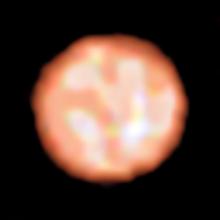Listen to today's episode of StarDate on the web the same day it airs in high-quality streaming audio without any extra ads or announcements. Choose a $8 one-month pass, or listen every day for a year for just $30.
You are here
Head of the Serpent
Some of the 88 constellations are a little disjointed. They meander in odd directions, making them hard to follow. But only one is really disjointed — it’s split into two parts.
They outline Serpens, the snake. One part represents its head, while the other contains its tail. They’re separated by the serpent bearer, Ophiuchus. The head is in the eastern sky at nightfall now, while the tail climbs into good view a couple of hours later. Ophiuchus is between them, with the snake curling behind his back.
The snake’s brightest star is in its head. It’s known as Alpha Serpentis or Unukalhai — from an Arabic name that means “the serpent’s neck.” It’s visible to the unaided eye under all but the most light-polluted skies.
Alpha Serpentis is a red giant. It’s used up the original hydrogen fuel in its core, and is now burning the helium “ash” to keep it going. That transition has made the core hotter, which has caused its outer layers to puff up like a giant balloon. In fact, the star is more than a dozen times the Sun’s diameter, and it’s likely to get even bigger.
Alpha Serpentis is also brighter than the Sun — roughly 40 times brighter at visible wavelengths. But as the star expanded it got cooler, turning it orange. Such cool stars produce a lot of infrared light. So when you add up all wavelengths, Alpha Serpentis is about 70 times brighter than the Sun — the brilliant head of the serpent.
More about Serpens tomorrow.
Script by Damond Benningfield





